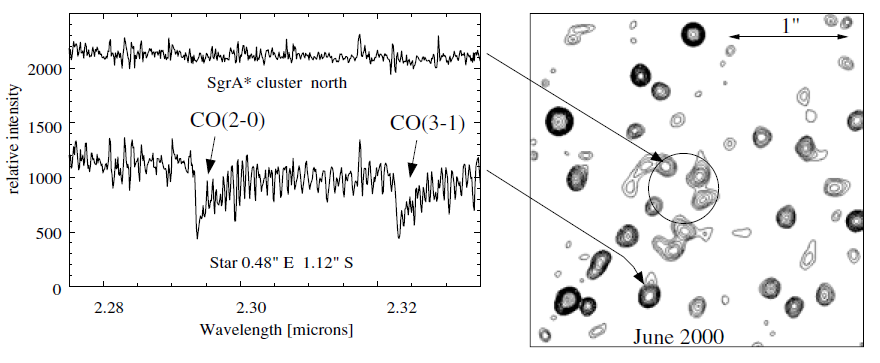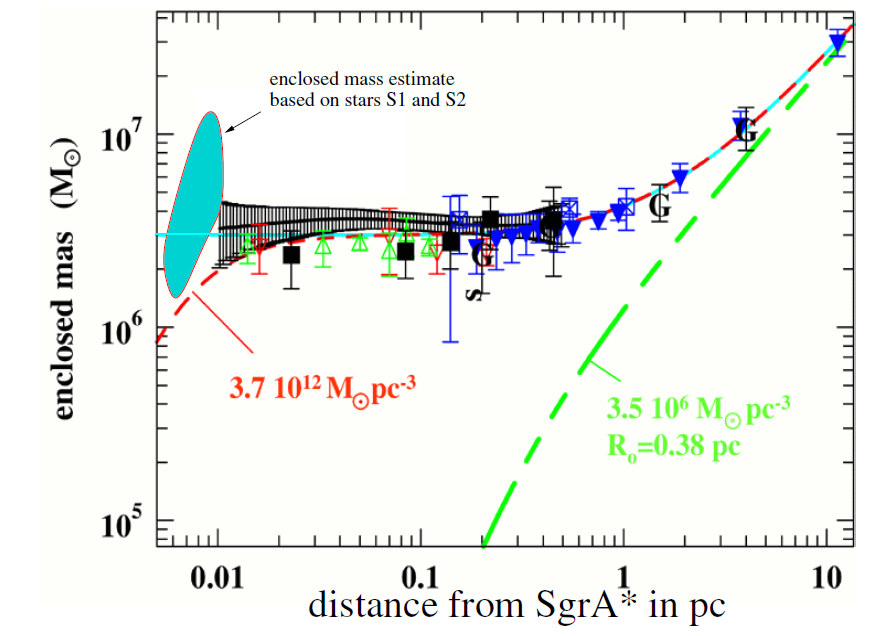


 الفيزياء الكلاسيكية
الفيزياء الكلاسيكية
 الكهربائية والمغناطيسية
الكهربائية والمغناطيسية
 علم البصريات
علم البصريات
 الفيزياء الحديثة
الفيزياء الحديثة
 النظرية النسبية
النظرية النسبية
 الفيزياء النووية
الفيزياء النووية
 فيزياء الحالة الصلبة
فيزياء الحالة الصلبة
 الليزر
الليزر
 علم الفلك
علم الفلك
 المجموعة الشمسية
المجموعة الشمسية
 الطاقة البديلة
الطاقة البديلة
 الفيزياء والعلوم الأخرى
الفيزياء والعلوم الأخرى
 مواضيع عامة في الفيزياء
مواضيع عامة في الفيزياء|
Read More
Date: 29-1-2017
Date: 2-2-2017
Date: 2-2-2017
|
Enclosed mass
Together with the VLBI maser nucleus of NGC 4258 (Greenhill et al 1995, Myoshi et al 1995) the compact dark mass in the Galactic Center is currently the best and most promising case for a supermassive nuclear black hole (Maoz 1998). The new anisotropy independent mass estimates (Leonard-Merritt estimators of the proper motions) as well as Jeans modeling (explicitly including velocity

Figure 1.1. Spectra of the CO(2-0) and CO(3-1) band head absorption toward the northern part of the central Sgr A∗ stellar cluster and a star to the south of it. The star and th northern area are indicated in a contour plot of the 2 μm continuum emission map from the central 2.9'' × 2.9'' as obtained with SHARP at the NTT.
anisotropy, see figure 1.2) result in a compact (<0.0058 pc) mass close to 2.9 × 106 Mּ with a mass density greater than 4 × 1012 Mּ pc−3 (Genzel et al 2000, see also Eckart et al 2001, 2002). One can show that any cluster of that mass at such a high density cannot be stable over more than 106–107 years (Maoz 1998). Equipartition arguments that include the known proper motions of the radio source Sgr A∗ (<16 km s−1, Backer 1996, Reid et al 1999, Genzel et al 2000) and the estimated mass and known proper motion of the inner fast moving stars (Eckart and Genzel 1997, Genzel et al 1997) result in a lower limit of at least 103 Mּ that has to be associated with Sgr A∗. The current conclusion is that this mass is most likely contained in a single massive black hole.
Due to the limited number of detected stars we currently use a minimum radius for our determination of the mass and mass density of 0.01 pc (0.25''). The α = 5 Plummer (see later) model of a dark cluster results in a core radius of such a hypothetical cluster of r0 = 0.0058 pc (0.23'') and corresponding central density of >4 × 1012 Mּ pc−3 (see earlier). The star S2 is currently at a distance of less than 0.1 from the center four times closer than the minimum radius previously mentioned. If the orbit of S2 remains consistent with a central unresolved mass of 2.9×106 Mּ the mass density is at least 64 times higher, i.e. 2.4×1014 Mּ pc−3. In this case the collapse life time would shrink to only a few 106 years, making the Galactic Center the strongest of all massive black hole candidates.
Figure 1.2 shows the mass distribution in the central 10 pc of the Galaxy obtained from stellar and gas dynamics (for R = 8.0 kpc). Bold ‘G's denote mass estimates from ionized and neutral gas dynamics. Rectangles with crosses and downward-pointing triangles denote the isotropic mass modeling of Genzel et al (1996, 1997), including Jeans modeling of stellar radial velocities (early- and late type stars, filled downward-pointing triangles) and Bahcall-Tremaine estimators of the NTT proper motions until 1996 (open down-pointing triangles; Eckart and Genzel 1997). Open rectangles (with crosses) are Bahcall-Tremaine estimators

Figure 1.2. The enclosed mass contained in circular apertures plotted as a function of their radius. The apertures are centered on the position of Sgr A∗. An explanation is given in the text. See also colour section.
of the line of sight velocity data only. Open upward-pointing triangles are the Bahcall-Tremaine estimators of the 1995–96 proper motion data of Ghez et al (1998). The new anisotropy-independent mass estimates from the present work are given as filled black rectangles from Leonard-Merritt estimators (Leonard and Merritt 1989) of the proper motions and as large black crosses connected by a continuous curve resulting from the Jeans modeling. For comparison several model curves are shown. The dashes represent the mass model for the (visible) stellar cluster ML(2 μm) = 2, rcore = 0.38 pc, ρ(r = 0) = 3.5 × 106 Mּ pc−3. The continuous curve is the sum of this stellar cluster, plus a point mass of 2.9 × 106 Mּ. The short dashes are the sum of the visible stellar cluster, plus an α = 5 Plummer model, ρ(r ) = ρ(0)[1 + (r/r0)2]−α/2, of a dark cluster of central density ∼4 × 1012 Mּ pc−3 and r0 = 0.0058 pc.



|
|
|
|
لصحة القلب والأمعاء.. 8 أطعمة لا غنى عنها
|
|
|
|
|
|
|
حل سحري لخلايا البيروفسكايت الشمسية.. يرفع كفاءتها إلى 26%
|
|
|
|
|
|
|
جامعة الكفيل تحتفي بذكرى ولادة الإمام محمد الجواد (عليه السلام)
|
|
|